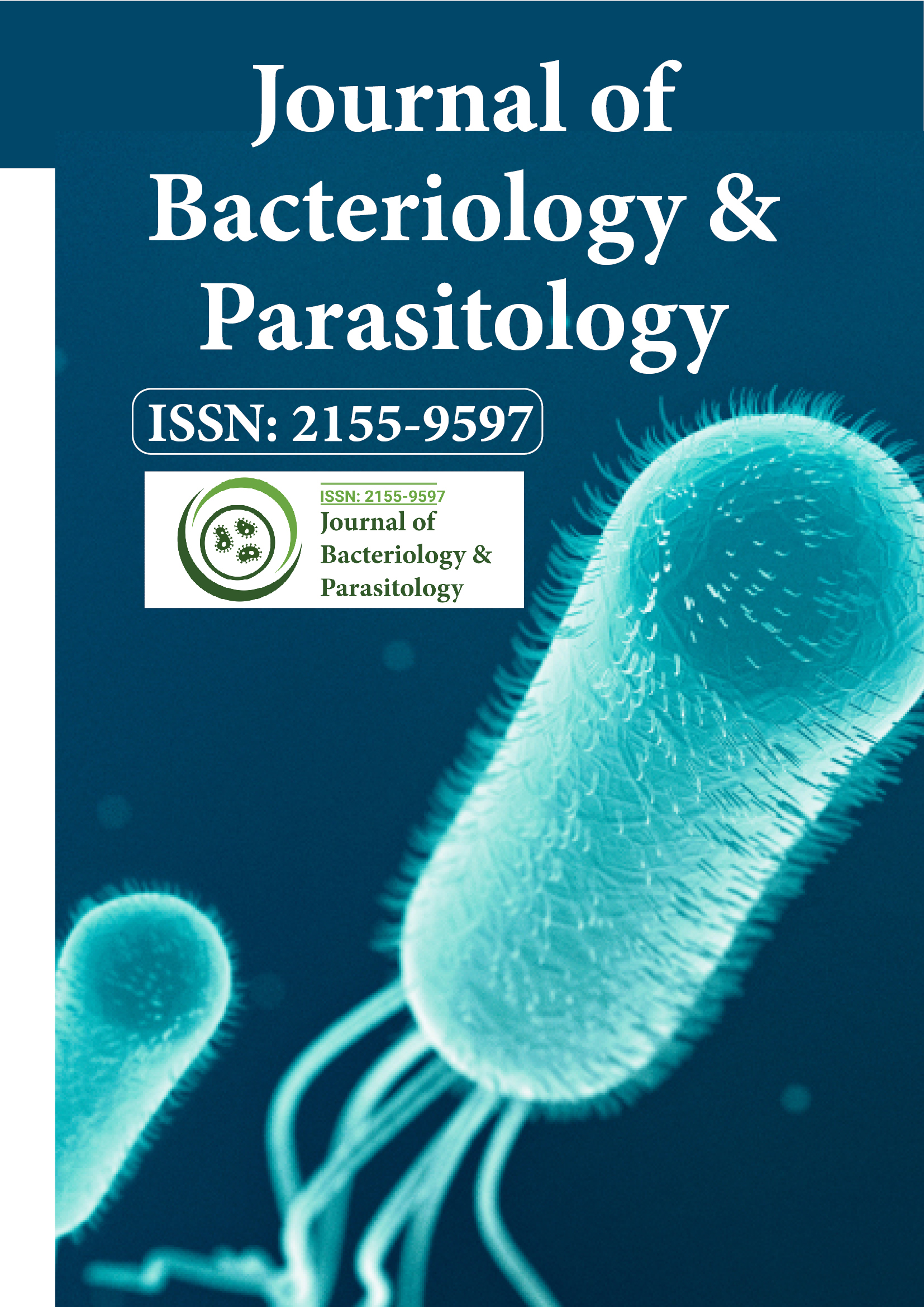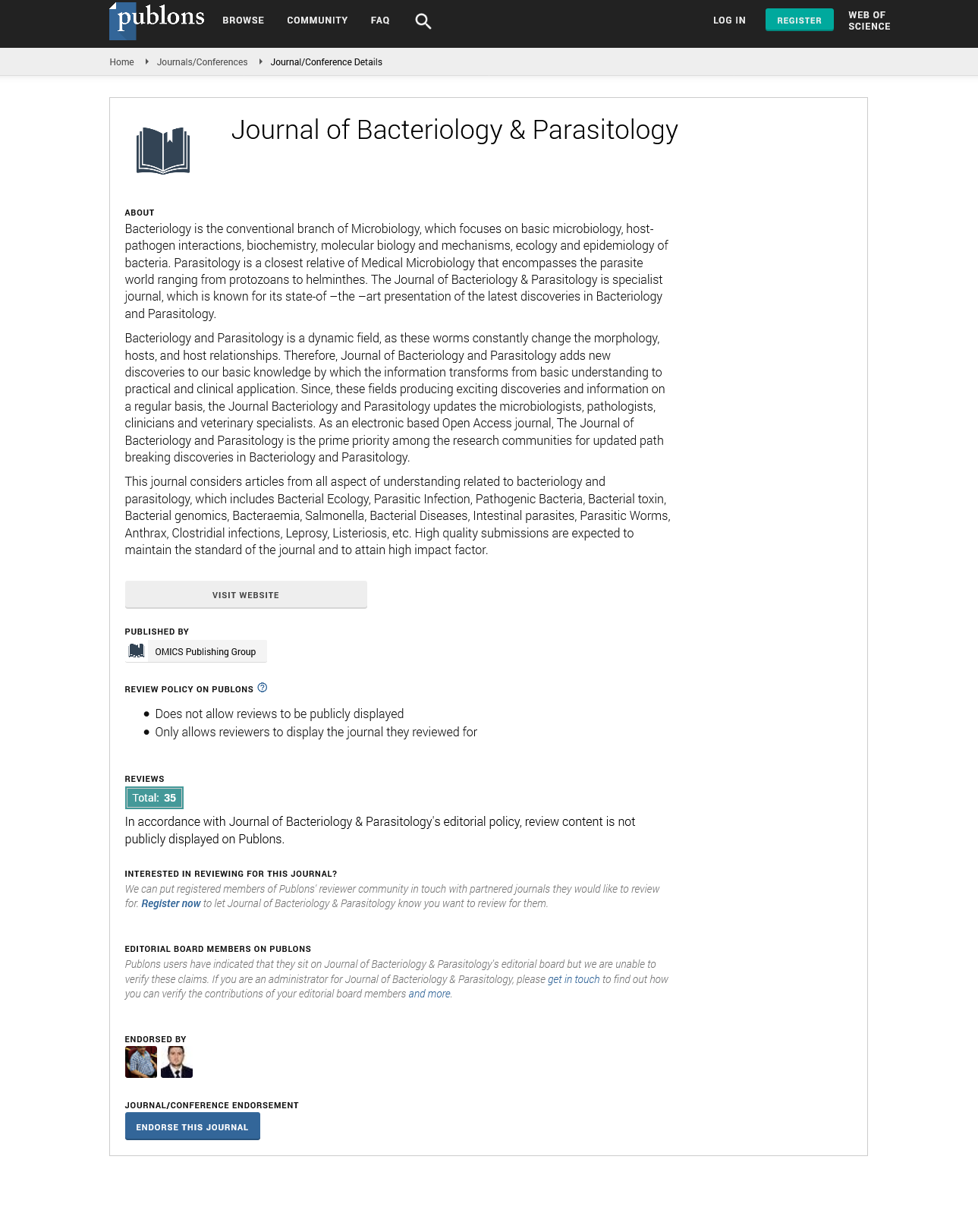Indexed In
- Open J Gate
- Genamics JournalSeek
- Academic Keys
- JournalTOCs
- ResearchBible
- Ulrich's Periodicals Directory
- Access to Global Online Research in Agriculture (AGORA)
- Electronic Journals Library
- RefSeek
- Hamdard University
- EBSCO A-Z
- OCLC- WorldCat
- SWB online catalog
- Virtual Library of Biology (vifabio)
- Publons
- MIAR
- Geneva Foundation for Medical Education and Research
- Euro Pub
- Google Scholar
Useful Links
Share This Page
Journal Flyer

Open Access Journals
- Agri and Aquaculture
- Biochemistry
- Bioinformatics & Systems Biology
- Business & Management
- Chemistry
- Clinical Sciences
- Engineering
- Food & Nutrition
- General Science
- Genetics & Molecular Biology
- Immunology & Microbiology
- Medical Sciences
- Neuroscience & Psychology
- Nursing & Health Care
- Pharmaceutical Sciences
Short Communication - (2025) Volume 16, Issue 3
Zoonotic Parasites: Transfer from Animals to Humans and Risk Mitigation
Victor Santos*Received: 26-May-2025, Manuscript No. JBP-25-30047; Editor assigned: 28-May-2025, Pre QC No. JBP-25-30047; Reviewed: 11-Jun-2025, QC No. JBP-25-30047; Revised: 18-Jun-2025, Manuscript No. JBP-25-30047; Published: 25-Jun-2025, DOI: 10.35248/2155-9597.25.16.554
Description
Animals serve as natural hosts to a wide variety of parasites, many of which can occasionally infect humans. These infections, known as zoonotic parasitic diseases, occur when parasites cross the barrier between animals and people. Such parasites include single-celled organisms, worms, and external parasites. Some require more than one host to complete their life cycle, while others spread through direct contact, ingestion of contaminated food or water, or transmission via insect vectors. The ways in which humans become infected often depend on their behaviors, environment, and interaction with animals.
One of the most common zoonotic parasites is a tiny organism found in many warm blooded animals, especially cats. People usually become infected by accidentally swallowing the parasite’s eggs shed in cat feces or by eating undercooked meat that contains the dormant form of the parasite. In most healthy individuals, the infection causes few or no symptoms. However, for pregnant women, it can be dangerous because the parasite may pass to the unborn baby, leading to miscarriage, developmental problems, or damage to the brain and eyes. People with weakened immune systems are also at risk of severe illness [1-3].
Another important zoonotic infection is caused by tapeworm larvae that lead to the formation of cysts in human organs, a condition commonly called hydatid disease. Humans become infected when they accidentally ingest eggs passed in the feces of infected dogs or other carnivores. Once inside the body, the larvae migrate and form fluid-filled cysts, often in the liver or lungs. These cysts can grow slowly for years, sometimes causing serious complications or requiring surgical removal.
A third example is a worm infection that results from eating undercooked meat particularly pork or wild game containing microscopic larvae. When humans consume such meat, the larvae develop and migrate through the bloodstream into muscles, where they cause pain, swelling, fever, and weakness. In severe cases, inflammation can affect the heart or nervous system, leading to more serious outcomes [4-7].
The risk of contracting these infections increases with close contact between humans and animals, poor hygiene, and inadequate cooking of meat. People who live in rural or farming communities may face higher risks because animals often roam freely, contaminating soil and water with their feces. Improper handling of meat, lack of sanitation in slaughterhouses, and unsafe butchering practices also contribute to transmission. Wild animals complicate control efforts, as they can maintain the parasites in nature and spread them beyond human supervision.
Diagnosis depends on the specific parasite involved. Doctors may use blood tests to detect antibodies or antigens that indicate infection. Imaging techniques such as ultrasound or CT scans can reveal cysts in internal organs. Stool samples may be examined for eggs or other parasite stages, while muscle biopsies can help confirm infections that affect muscle tissue. Newer molecular methods allow for more precise identification of the parasites, which is important because treatment can vary depending on the type and stage of infection. However, some infections remain dormant for years, making detection challenging.
Treatment also differs by parasite. Infections acquired from cats or undercooked meat are often treated with a combination of specialized antiparasitic and antibiotic drugs. Cyst-forming infections may require surgical removal of large cysts along with long-term medication to prevent regrowth. Worm infections from meat consumption are treated with antiparasitic drugs that kill the larvae and help relieve symptoms. For pregnant women, doctors must carefully choose safe treatment options to avoid harm to the fetus. Long-term follow-up is often needed to monitor for recurrence or complications [8-10].
Conclusion
Monitoring the spread of zoonotic parasites provides valuable insight into how outbreaks emerge and evolve. Changes in land use, urban expansion, increased meat trade, and closer contact between wildlife and humans all influence infection patterns. Climate change also plays a growing role by shifting the habitats of animals and parasites, creating new opportunities for transmission. Surveillance programs that track parasite presence in animals, humans, and the environment are essential for early detection and response. By understanding how these parasites move between animals and humans, societies can better protect themselves from infections that not only affect individuals but also pose challenges to global health and food security.
References
- Even-Desrumeaux K, Baty D, Chames P. State of the art in tumor antigen and biomarker discovery. Cancers. 2011;3(2):2554-2596.
[Crossref]
- Cho JH, Collins JJ, Wong WW. Universal chimeric antigen receptors for multiplexed and logical control of T cell responses. Cell. 2018;173(6):1426-1438.
[Crossref]
- Kumar MA, Baba SK, Sadida HQ, Marzooqi SA, Jerobin J, Altemani FH, et al. Extracellular vesicles as tools and targets in therapy for diseases. Signal Transduct Target Ther. 2024;9(1):27.
[Crossref]
- Brown AF, Murphy AG, Lalor SJ, Leech JM, O’Keeffe KM, Mac Aogáin M, et al. Memory Th1 cells are protective in invasive Staphylococcus aureus infection. PLoS Pathog. 2015;11(11):e1005226.
[Crossref]
- Rosenthal R, Cadieux EL, Salgado R, Bakir MA, Moore DA, Hiley CT, et al. Neoantigen-directed immune escape in lung cancer evolution. Nature. 2019;567(7749):479-485.
[Crossref]
- Roybal KT, Williams JZ, Morsut L, Rupp LJ, Kolinko I, Choe JH, et al. Engineering T cells with customized therapeutic response programs using synthetic notch receptors. Cell. 2016;167(2):419-432.
[Crossref]
- Margo CE, Harman LE. Autoimmune disease: Conceptual history and contributions of ocular immunology. Surv Ophthalmol. 2016;61(5):680-688.
[Crossref]
- Foster CS, Kothari S, Anesi SD, Vitale AT, Chu D, Metzinger JL, et al. The Ocular Immunology and Uveitis Foundation preferred practice patterns of uveitis management. Surv Ophthalmol. 2016;61(1):1-7.
[Crossref]
- Zierhut M, Dana MR, Stern ME, Sullivan DA. Immunology of the lacrimal gland and ocular tear film. Trends Immunol. 2002;23(7):333-335.
[Crossref]
- Mursalin MH, Astley R, Coburn PS, Bagaruka E, Hunt JJ, Fischetti VA, et al. Therapeutic potential of Bacillus phage lysin PlyB in ocular infections. mSphere. 2023;8(4):00044-00023.
[Crossref]
Citation: Santos V (2025). Zoonotic Parasites: Transfer from Animals to Humans and Risk Mitigation. J Bacteriol Parasitol. 16:554.
Copyright: © 2025 Santos V. This is an open-access article distributed under the terms of the Creative Commons Attribution License, which permits unrestricted use, distribution and reproduction in any medium, provided the original author and source are credited.

